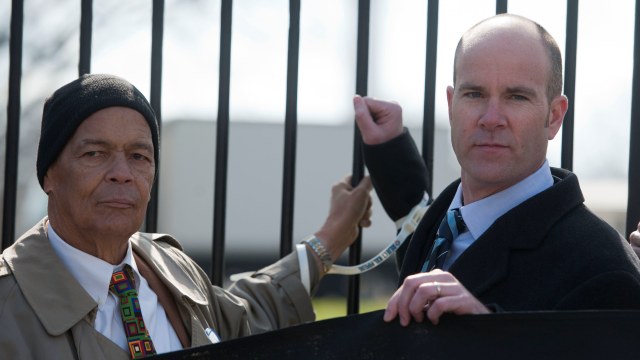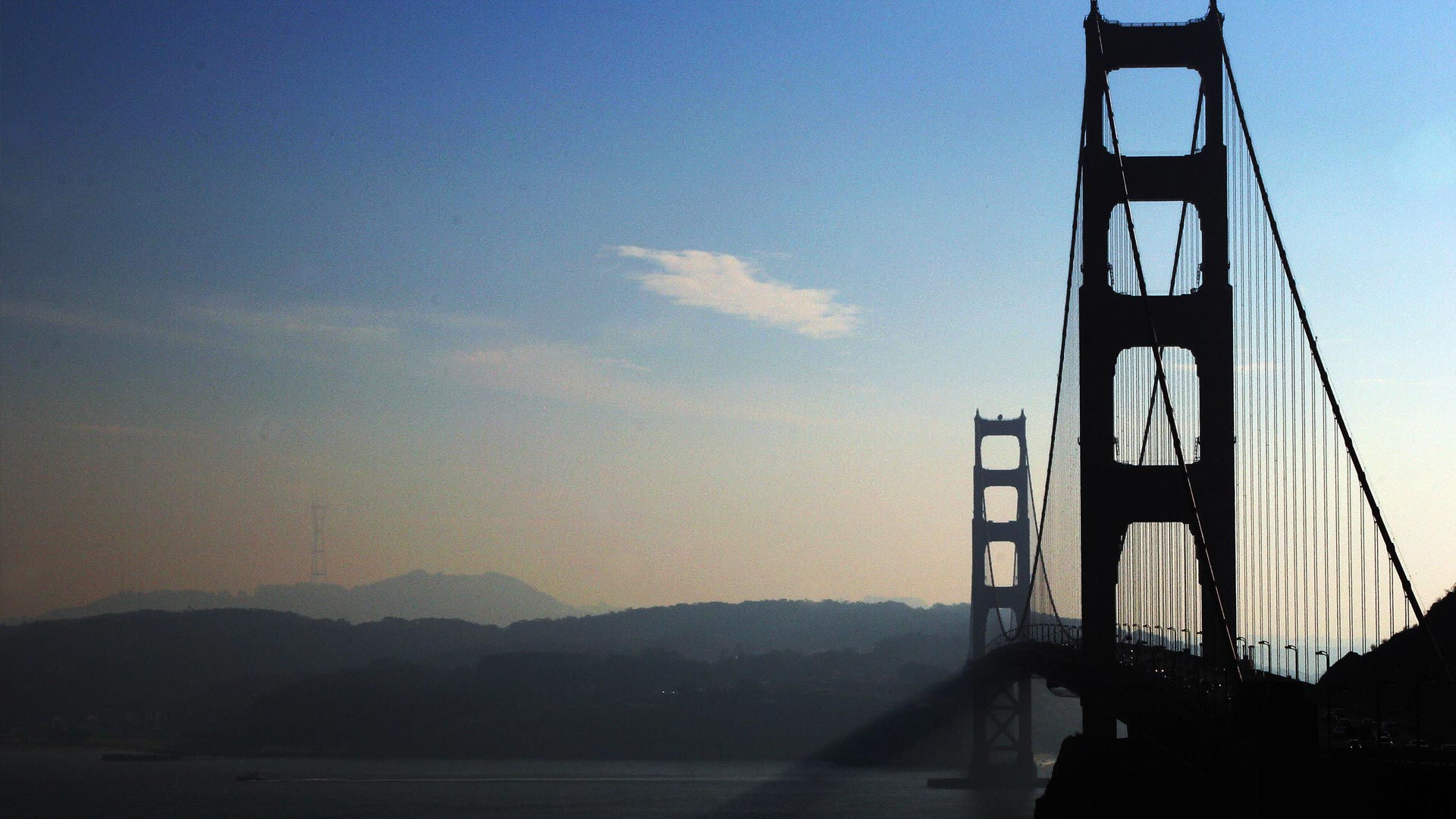Sierra Club Director: Time to Take Climate Action to the Streets

Sierra Club Director: Time to Take Climate Action to the Streets

In the week leading up to Presidents' Day, Michael Brune, the national executive director of the Sierra Club, found himself in handcuffs, after strapping himself to the White House gates. He and other protesters are hoping to spur President Obama toward bold action to combat climate change with what's being billed as the biggest rally ever for climate action in this country. The Presidents' Day events in several cities, including San Francisco, where the Sierra Club is headquartered, mark a new, more aggressive stance for the organization spawned by John Muir. Brune's arrest was the first of a Sierra Club chief in the club's 120-year history.
Brune's not just rattling the gates from the outside, though. He managed to get sprung in time for the Valentine's Day roll-out of a major climate bill by Democratic Senators Barbara Boxer and Bernie Sanders. It would tax carbon emissions, tighten regulations on fracking and provide investments for clean energy and energy efficiency upgrades.
KQED Science Editor Craig Miller sat down with Brune before he left for Washington to talk with him about climate action, the Keystone XL pipeline, and fracking. This is an edited transcript of their conversation.
Craig Miller: Many people were stunned when the president devoted a full paragraph to the climate issue in his inaugural address. Were you among those stunned people up there?
Michael Brune: I was certainly very pleased. The president gave more word space to climate change than any other issue during his inauguration. He articulated both the moral obligation we have to fight climate change and the fact that when we transition to clean energy, there will be great economic benefit brought to all Americans. So it was very encouraging.
Miller: Surprising talk, but on the action front how would you grade this president so far? Have you been a little disappointed?
Brune: Looking at his first term, you can simultaneously say that the president did more than any other president when it comes to climate change, particularly if you look at all the rules that the EPA put forward to improve public health that had an impact on fossil fuels. You could say he has done an insufficient job in that there’s a lot of things the president could do and should do that he hasn’t yet done.
Miller: I think the reason a lot of people were surprised was the word climate just about disappeared from his vocabulary for an extended period of time.
Brune: Yeah, you know that’s disappointing. There’s really no other way to put it other than the fact that the president has the opportunity to lead not just the American people, but to lead the world in an all-out, concerted, thoughtful, but relentless effort to move away from dirty fuels and to embrace clean energy. He has to talk about climate every time that there’s another massive wildfire, or a crippling drought, or another super-storm hits. We have to be able to connect these extreme weather events to the fact that our climate is destabilizing as we speak. This is not something that can be addressed through the occasional mention or even the occasional rule put forward by his administration.
Miller: Do you think there’s been a sort of – no pun intended – sea change, a shift? Are people, are policymakers ready to see and hear what’s happening in your opinion?
Brune: I think so. I spend a fair amount of time on Capitol Hill and you can tell people’s opinions have shifted just in the last six months. The reason for that is the American public’s opinions have shifted. There was a poll put out last week by Duke University that said 84% of all Americans believe that climate change is real, it’s man-made, it’s happening and that the solutions to climate change are here. So you’re seeing that reflected in a thawing, let’s say, of some of the attitudes that we often see on Capitol Hill. The question remains is whether or not this will lead to meaningful action.
Miller: So what’s the most important first step that the president and Congress could take right now?
Brune: Job one is to reject the Keystone XL pipeline. We should not be building out new fossil fuel infrastructure at the same time we want to reduce greenhouse gas emissions.
Miller: This is the big pipeline that is designed to bring Canadian oil sands all the way down to the Gulf Coast for refining. There’s a lot of opposition to it, but here in California, it’s an issue that feels remote to a lot of people. Why does it matter to us out here?
Brune: There are two reasons why it matters. First is that this would be the biggest pipeline coming down from the tar sands. The tar sands is the dirtiest oil on the planet, and this pipeline would take 830,000 barrels of oil from the tar sands every day, bring it all the way through this country, and then have most of it be exported outside the U.S. borders. This will, by itself, contribute to global warming. But it’s also a symbol of the fact that we cannot continue to invest in dirty fuel sources whether it’s drilling in the Arctic, mountaintop removal in Appalachia, this tar sands project, fracking that’s happening across the country. We can’t continue to put billions of dollars of infrastructure into fossil fuels when we need to start investing that money toward clean energy solutions instead.
Miller: In fact, we’re waiting to hear from the president on (the Keystone XL project) issue. What if he approves it? What then?
Brune: We’re actually waiting to hear from the president on all of these issues. We’re waiting to hear from the president on how drilling should take place in the Arctic when we’re trying to reduce our dependence on fossil fuels. We’re waiting to see leadership from the president on the tar sands, as well. We’re waiting for a ruling that this pipeline should not be built. We’d like to see the president take on fracking as well as mountaintop removal.
The big rally on the National Mall was designed to inspire the president so that his ambition meets the scale of this challenge. We want to see the president reject the Keystone XL pipeline, but we want to see him go much farther than that. There’s an opportunity to regulate carbon pollution from smokestacks and refineries all across the country. There’s an opportunity to turn away from Arctic drilling and there’s an even bigger opportunity to invest in clean energy like solar and wind that will help to replace these dirty fuels. That creates more jobs and cuts air and water emissions at the same time.
Miller: Let’s talk about fracking. This is short for hydraulic fracturing the tech used to extract oil and gas from underground rock formations, stuff that was tough to get at before new technology made it possible. They’ve been fracking in California for oil in different ways but now it seems like there’s this new boom on its way here with the Monterey shale formation in Central California. How concerned are you about that?
Brune: As a parent, I’m very concerned about the impacts of fracking on our air, our water and our climate particularly when there are much better solutions to meet our energy needs, particularly in California, where we’ve got solar that’s just growing by leaps and bounds and wind resources that are not fully utilized. We know that in the 21st century our economy will be based on energy that’s safe, secure and sustainable. We don’t need to be investing in fracking, or more oil drilling, mountaintop removal or more coal mining when we know that solar and wind can do a better job.
Miller: But you can’t just throw a switch and tomorrow morning everything’s clean and renewable. In 2012, for example, U.S. greenhouse gas emissions fell to their lowest point in 20 years, and a lot of the credit for that is going to fracking for gas – cheap natural gas – which is cleaner than burning coal. Don’t you need to do some of that?
Brune: Let’s be really clear here. Greenhouse gas emissions have fallen to 20 year lows and the reason for that is not because of fracking -- in no way, shape or form. The reason for that is we are replacing coal plants with a variety of clean energy sources. In most cases, wind and solar are taking up a bigger share of the energy mix than fracking ever is. Case in point, in 2012 there were more new wind resources brought online than natural gas. There was more solar and wind than all fossil fuel sources combined. What we are seeing right now is the United States slowly, but with increasing speed, is beginning to get off of fossil fuels -- at a much slower pace than we should, but it’s starting to happen.
Miller: Going back to the D.C. rally, this kind of street-level activism is kind of a new direction for the Sierra Club, and it’s pretty much your doing since you took over. You must be getting some push back from some members who still see the primary mission of the Sierra Club as conservation of public lands and restoration of natural resources. Are you hearing some of that?
Brune: Not really. The mission of the Sierra Club is very simple. It’s to explore, enjoy and protect the planet. We have Sierra Club members who have been volunteering with us for decades, some members who have been volunteering for a couple weeks, but all of them are united around a very simple credo. We know that getting into the outdoors inspires further activism and we also know that there are solutions to some of our country’s biggest environmental problems. The demonstration on the National Mall over the weekend and the rallies we are holding across the country really does tap into a long-held tradition that Sierra Club members want to participate in bringing out solutions to our country’s problems, and they know there are a lot of ways to get there.
Miler: We had Jim Hansen here in the same studio for an interview recently – a certified climate change legend from NASA – who says that California’s whole approach is half-baked. We’d be much better off with a straight-on carbon tax than this complicated market-based cap-and-trade system that we’re using.
Brune: Hansen has a point. Most economists that you talk to will view a carbon tax as a much more efficient and, thus, much more effective way of putting a price on carbon and hastening a tradition toward clean energy resources. But it’s also true that California is making more progress than any other state in de-carbonizing and transitioning to clean energy.
Miller: Speaking of presidential decisions, Sally Jewell is Mr. Obama’s choice for the new Secretary of the Interior, currently the CEO of REI, the outdoor clothing and gear company out of Seattle. What specifically does Jewell bring to the table?
Brune: What Sally brings is potential for a sea change in terms of how the Department of Interior looks at natural resources. For the last century or more, most people who have been in her position have looked at the oil, or timber or gas as a resource to exploit. What Sally recognizes is that there’s more economic gain from protecting our public resources, but also there’s great opportunity to expand protection to benefit wildlife, landscapes and the communities that surround them. We’re very optimistic that when she assumes this position, we’ll have a great opportunity to get more people in the outdoors and then have those folks be active part in helping to protect our last remaining natural treasures.
